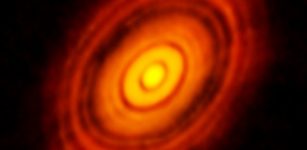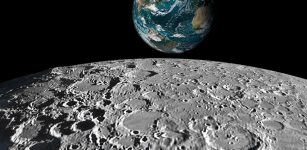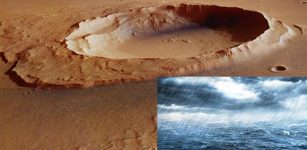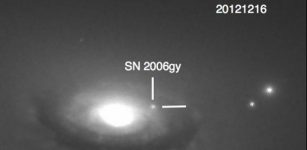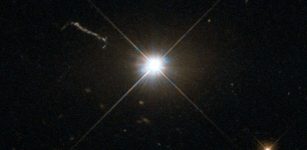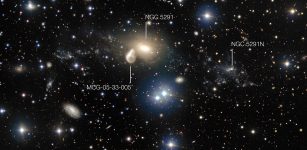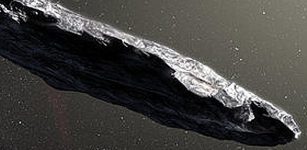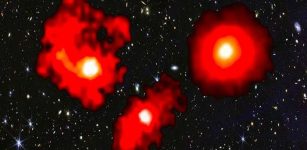“Hit-And-Run-Return” Scenario: Earth And Venus Grew Up As Rambunctious Planets
Eddie Gonzales Jr. – MessageToEagle.com – What doesn’t stick comes around: Using machine learning and simulations of giant impacts, researchers at the Lunar and Planetary Laboratory found that the planets residing in the inner solar systems were likely born from repeated hit-and-run collisions, challenging conventional models of planet formation.
 Artist’s illustration of two massive objects colliding. Credit: NASA/JPL-Caltech
Artist’s illustration of two massive objects colliding. Credit: NASA/JPL-Caltech
Planet formation—the process by which neat, round, distinct planets form from a roiling, swirling cloud of rugged asteroids and mini planets—was likely even messier and more complicated than most scientists would care to admit, according to new research led by researchers at the University of Arizona Lunar and Planetary Laboratory.
The findings challenge the conventional view, in which collisions between smaller building blocks cause them to stick together and, over time, repeated collisions accrete new material to the growing baby planet.
Instead, the authors propose and demonstrate evidence for a novel “hit-and-run-return” scenario, in which pre-planetary bodies spent a good part of their journey through the inner solar system crashing into and ricocheting off of each other, before running into each other again at a later time. Having been slowed down by their first collision, they would be more likely to stick together the next time. Picture a game of billiards, with the balls coming to rest, as opposed to pelting a snowman with snowballs, and you get the idea.
The research is published in two reports with one focusing on Venus and Earth, and the other on Earth’s moon. Central to both publications, according to the author team, which was led by planetary sciences and LPL professor Erik Asphaug, is the largely unrecognized point that giant impacts are not the efficient mergers scientists believed them to be.
“We find that most giant impacts, even relatively ‘slow’ ones, are hit-and-runs. This means that for two planets to merge, you usually first have to slow them down in a hit-and-run collision,” Asphaug said. “To think of giant impacts, for instance, the formation of the moon, as a singular event is probably wrong. More likely it took two collisions in a row.”
One implication is that Venus and Earth would have had very different experiences in their growth as planets, despite being immediate neighbors in the inner solar system. In this paper, led by Alexandre Emsenhuber, who did this work during a postdoctoral fellowship in Asphaug’s lab and is now at Ludwig Maximilian University in Munich, the young Earth would have served to slow down interloping planetary bodies, making them ultimately more likely to collide with and stick to Venus.
The terrestrial planets of the inner solar system, shown to scale. According to ‘late stage accretion’ theory, Mars and Mercury (front left and right) are what’s left of an original population of colliding embryos, and Venus and Earth grew in a series of giant impacts. New research focuses on the preponderance of hit-and-run collisions in giant impacts, and shows that proto-Earth would have served as a ‘vanguard’, slowing down planet-sized bodies in hit-and-runs. But it is proto-Venus, more often than not, that ultimately accretes them, meaning it was easier for Venus to acquire bodies from the outer solar system. Credit: Lsmpascal – Wikimedia commons
“We think that during solar system formation, the early Earth acted like a vanguard for Venus,” Emsenhuber said.
The solar system is what scientists call a gravity well, the concept behind a popular attraction at science exhibits. Visitors toss a coin into a funnel-shaped gravity well, and then watch their cash complete several orbits before it drops into the center hole. The closer a planet is to the sun, the stronger the gravitation experienced by planets. That’s why the inner planets of the solar system on which these studies were focused—Mercury, Venus, Earth and Mars—orbit the sun faster than, say, Jupiter, Saturn and Neptune. As a result, the closer an object ventures to the sun, the more likely it is to stay there.
So when an interloping planet hit the Earth, it was less likely to stick to Earth, and instead more likely to end up at Venus, Asphaug explained.
“The Earth acts as a shield, providing a first stop against these impacting planets,” he said. “More likely than not, a planet that bounces off of Earth is going to hit Venus and merge with it.”
Emsenhuber uses the analogy of a ball bouncing down a staircase to illustrate the idea of what drives the vanguard effect: A body coming in from the outer solar system is like a ball bouncing down a set of stairs, with each bounce representing a collision with another body.
“Along the way, the ball loses energy, and you’ll find it will always bounce downstairs, never upstairs,” he said. “Because of that, the body cannot leave the inner solar system anymore. You generally only go downstairs, toward Venus, and an impactor that collides with Venus is pretty happy staying in the inner solar system, so at some point it is going to hit Venus again.”
Earth has no such vanguard to slow down its interloping planets. This leads to a difference between the two similar-sized planets that conventional theories cannot explain, the authors argue.
“The prevailing idea has been that it doesn’t really matter if planets collide and don’t merge right away, because they are going to run into each other again at some point and merge then,” Emsenhuber said. “But that is not what we find. We find they end up more frequently becoming part of Venus, instead of returning back to Earth. It’s easier to go from Earth to Venus than the other way around.”
To track all these planetary orbits and collisions, and ultimately their mergers, the team used machine learning to obtain predictive models from 3D simulations of giant impacts. The team then used these data to rapidly compute the orbital evolution, including hit-and-run and merging collisions, to simulate terrestrial planet formation over the course of 100 million years. In the second paper, the authors propose and demonstrate their hit-and-run-return scenario for the moon’s formation, recognizing the primary problems with the standard giant impact model.
“The terrestrial planets of the inner solar system, shown to scale. According to ‘late stage accretion’ theory, Mars and Mercury (front left and right) are what’s left of an original population of colliding embryos, and Venus and Earth grew in a series of giant impacts. New research focuses on the preponderance of hit-and-run collisions in giant impacts, and shows that proto-Earth would have served as a ‘vanguard’, slowing down planet-sized bodies in hit-and-runs. But it is proto-Venus, more often than not, that ultimately accretes them, meaning it was easier for Venus to acquire bodies from the outer solar system. Credit: Lsmpascal – Wikimedia commons”
“The standard model for the moon requires a very slow collision, relatively speaking,” Asphaug said, “and it creates a moon that is composed mostly of the impacting planet, not the proto-Earth, which is a major problem since the moon has an isotopic chemistry almost identical to Earth.”
In the team’s new scenario, a roughly Mars-sized protoplanet hits the Earth, as in the standard model, but is a bit faster so it keeps going. It returns in about 1 million years for a giant impact that looks a lot like the standard model.
“The double impact mixes things up much more than a single event,” Asphaug said, “which could explain the isotopic similarity of Earth and moon, and also how the second, slow, merging collision would have happened in the first place.”
The researchers think the resulting asymmetry in how the planets were put together points the way to future studies addressing the diversity of terrestrial planets. For example, we don’t understand how Earth ended up with a magnetic field that is much stronger than that of Venus, or why Venus has no moon.
Their research indicates systematic differences in dynamics and composition, according to Asphaug.
“In our view, Earth would have accreted most of its material from collisions that were head-on hits, or else slower than those experienced by Venus,” he said. “Collisions into the Earth that were more oblique and higher velocity would have preferentially ended up on Venus.”
This would create a bias in which, for example, protoplanets from the outer solar system, at higher velocity, would have preferentially accreted to Venus instead of Earth. In short, Venus could be composed of material that was harder for the Earth to get ahold of.
“You would think that Earth is made up more of material from the outer system because it is closer to the outer solar system than Venus. But actually, with Earth in this vanguard role, it makes it actually more likely for Venus to accrete outer solar system material,” Asphaug said.
source – Phys.org
Written by Eddie Gonzales Jr. MessageToEagle.com Staff



